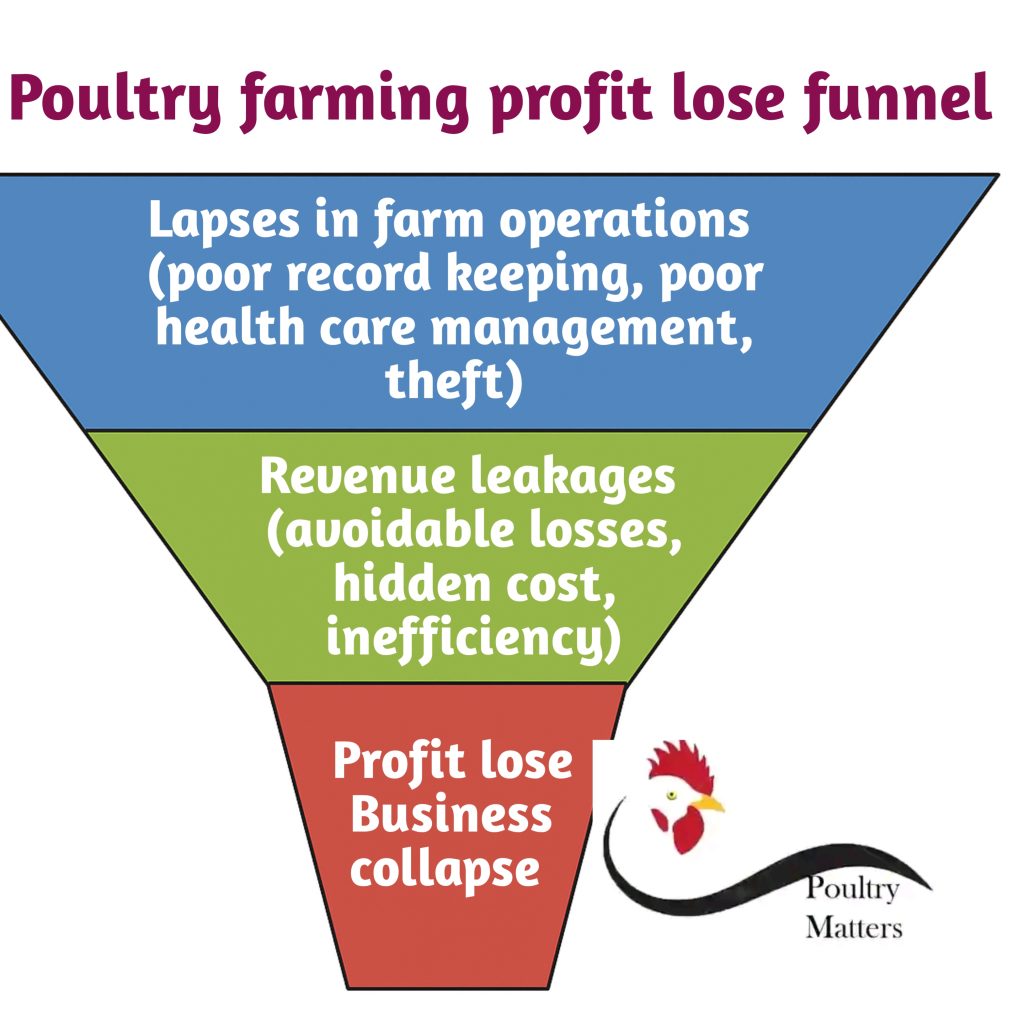Leakages in poultry business revenue – common causes and how they affect profitability
Profitability in poultry farming depends not only on production capacity but also on effective management of costs, risks, and operations. Unfortunately, many farmers experience profit leakages. Profit leakages are avoidable losses that silently drain revenue and reduce the overall sustainability of the businesses. Recognizing these areas of leakage is the first step toward building a more profitable and resilient poultry enterprise.
–Some common causes of poultry revenue leakage and how they affect profitability
- Poor Record-Keeping – Without proper financial and operational records, farmers cannot accurately track expenses, sales or production performance. This lack of clear-visibility hides true costs and masks potential profit margins, leading to misinformed decisions.
- Overfeeding Birds – Excess feed beyond the birds’ nutritional requirements increases costs unnecessarily. Since feed represents 60–70% of poultry production expenses, wastage in this area directly reduces profit.
- Underfeeding Birds – Inadequate feed or poor-quality rations prevent birds from reaching optimal weight or laying capacity. This limits growth, egg production and ultimately sales revenue. Poor earnings in sales directly impacts on the farm’s profitability adversely.
- High Mortality Rates – Losses due to diseases, poor welfare management or accidents significantly reduce the overall stock value and production potential. High mortality is often a reflection of weak preventive measures.
- Theft of Eggs, Birds or Feed – Internal and external theft is a silent but common drain on poultry revenue. Without strict monitoring and accountability systems, farmers most times lose significant portion of their investment without realizing it.
- Delayed Vaccination and poor biosecurity – Postponing or skipping vaccinations exposes the flock to preventable diseases. Also. weak disease-prevention protocols allow infections to reoccur, creating cycles of treatment costs, reduced productivity and high mortality. Treating outbreaks is costlier than prevention and often results in long-term production losses. Disease prevention is always better that cure.
- Poor Housing Conditions – Weak or sub-standard housing leaves birds vulnerable to predators, extreme weather and stress. These factors lead to reduced survival, growth and productivity of the flock. Poor production also lead to poor profitability of the farm operations.
- Feed Wastage During Distribution – Inefficient feeding systems—such as poorly designed troughs or careless staff—cause significant feed spillage. Over time, this translates into substantial financial loss. Similarly, improper storage exposes feed to spoilage or lose of nutritional value. Birds consuming spoiled feed perform poorly, reducing overall returns.
- Low Frequency of Egg Collection – Eggs left too long in nesting areas crack, spoil, or are eaten by other birds. Frequent collection maximizes the number of marketable eggs available for sale.
- Selling at Low Market Prices – Inconsistent pricing or selling below market value reduces profit margins. Farmers who fail to explore better markets or negotiate fair prices often struggle with low returns.
- Lack of Targeted Buyers – Operating without a reliable buyer network leads to irregular sales. This results in unsold stock, reduced bargaining power and potential wastage.
- Untrained or Inefficient Staff – Employees without proper training often mishandle feed, birds, and equipment. This mismanagement translates into resource wastage, reduced production efficiency, and financial loss.

Difference between revenue leakages and direct looses in your poultry operations
Revenue leakages are small, often unnoticed financial drains that reduce profitability of the farm operations over time. Examples of such leakages are – overfeeding birds, poor record-keeping or minor theft. Leakages usually occur gradually and are hidden within daily operations.
Direct losses, on the other hand, are clear, visible and immediate setbacks in the farm earning capability. Looses are usually traced to sudden occurrences such as – bird mortality, major disease outbreaks or fire damage. Direct looses are easy to identify and can be accounted for.
In summary, while leakages are silent, gradual drains on revenue, direct losses are obvious, immediate hits on the farm profit.
Conclusion
Revenue leakages in poultry farming are often small and gradual but accumulate into significant losses over time. However, by addressing these areas of lapses through good management practices, staff training, proper record-keeping, and strategic investment, farmers can reduce waste, improve efficiency and secure higher profits.
Read more https://poultrygist.com.ng/2025/09/common-mistakes-to-avoid-in-poultry-profit-planning/
Download free samples of farm record templates https://drive.google.com/file/d/1l4p6RXl1D2fPQmsli_cpWZRO_upeFxdc/view?usp=sharing
